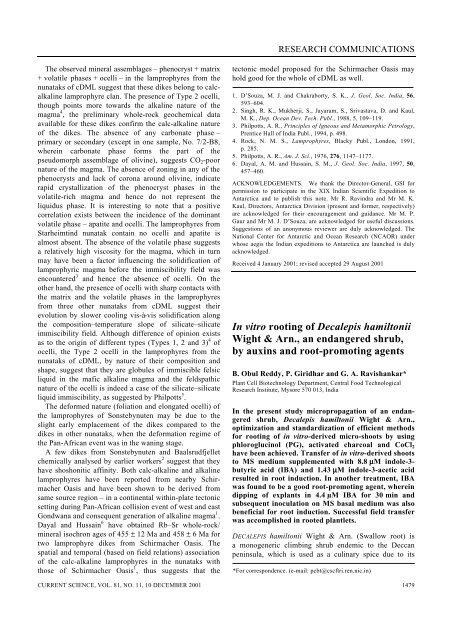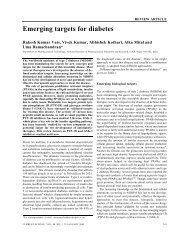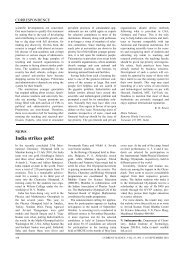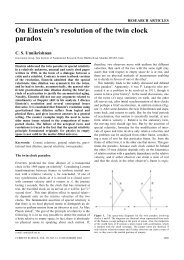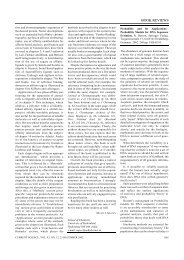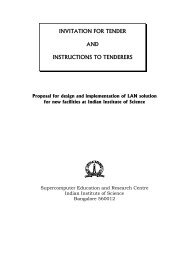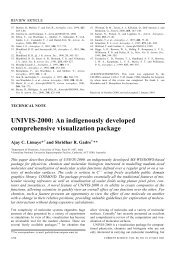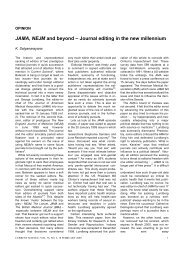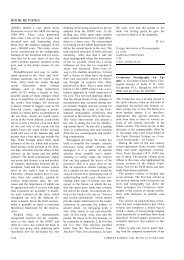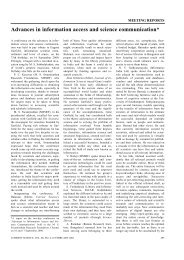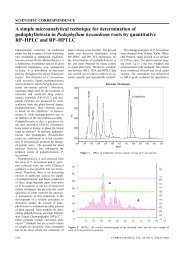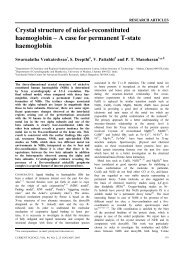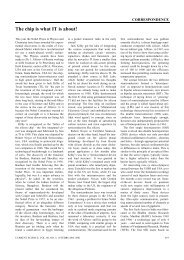In vitro rooting of Decalepis hamiltonii Wight & Arn., an endangered ...
In vitro rooting of Decalepis hamiltonii Wight & Arn., an endangered ...
In vitro rooting of Decalepis hamiltonii Wight & Arn., an endangered ...
You also want an ePaper? Increase the reach of your titles
YUMPU automatically turns print PDFs into web optimized ePapers that Google loves.
RESEARCH COMMUNICATIONS<br />
The observed mineral assemblages – phenocryst + matrix<br />
+ volatile phases + ocelli – in the lamprophyres from the<br />
nunataks <strong>of</strong> cDML suggest that these dikes belong to calcalkaline<br />
lamprophyre cl<strong>an</strong>. The presence <strong>of</strong> Type 2 ocelli,<br />
though points more towards the alkaline nature <strong>of</strong> the<br />
magma 4 , the preliminary whole-rock geochemical data<br />
available for these dikes confirm the calc-alkaline nature<br />
<strong>of</strong> the dikes. The absence <strong>of</strong> <strong>an</strong>y carbonate phase –<br />
primary or secondary (except in one sample, No. 7/2-B8,<br />
wherein carbonate phase forms the part <strong>of</strong> the<br />
pseudomorph assemblage <strong>of</strong> olivine), suggests CO 2 -poor<br />
nature <strong>of</strong> the magma. The absence <strong>of</strong> zoning in <strong>an</strong>y <strong>of</strong> the<br />
phenocrysts <strong>an</strong>d lack <strong>of</strong> corona around olivine, indicate<br />
rapid crystallization <strong>of</strong> the phenocryst phases in the<br />
volatile-rich magma <strong>an</strong>d hence do not represent the<br />
liquidus phase. It is interesting to note that a positive<br />
correlation exists between the incidence <strong>of</strong> the domin<strong>an</strong>t<br />
volatile phase – apatite <strong>an</strong>d ocelli. The lamprophyres from<br />
Starheimtind nunatak contain no ocelli <strong>an</strong>d apatite is<br />
almost absent. The absence <strong>of</strong> the volatile phase suggests<br />
a relatively high viscosity for the magma, which in turn<br />
may have been a factor influencing the solidification <strong>of</strong><br />
lamprophyric magma before the immiscibility field was<br />
encountered 3 <strong>an</strong>d hence the absence <strong>of</strong> ocelli. On the<br />
other h<strong>an</strong>d, the presence <strong>of</strong> ocelli with sharp contacts with<br />
the matrix <strong>an</strong>d the volatile phases in the lamprophyres<br />
from three other nunataks from cDML suggest their<br />
evolution by slower cooling vis-à-vis solidification along<br />
the composition–temperature slope <strong>of</strong> silicate–silicate<br />
immiscibility field. Although difference <strong>of</strong> opinion exists<br />
as to the origin <strong>of</strong> different types (Types 1, 2 <strong>an</strong>d 3) 4 <strong>of</strong><br />
ocelli, the Type 2 ocelli in the lamprophyres from the<br />
nunataks <strong>of</strong> cDML, by nature <strong>of</strong> their composition <strong>an</strong>d<br />
shape, suggest that they are globules <strong>of</strong> immiscible felsic<br />
liquid in the mafic alkaline magma <strong>an</strong>d the feldspathic<br />
nature <strong>of</strong> the ocelli is indeed a case <strong>of</strong> the silicate–silicate<br />
liquid immiscibility, as suggested by Philpotts 5 .<br />
The deformed nature (foliation <strong>an</strong>d elongated ocelli) <strong>of</strong><br />
the lamprophyres <strong>of</strong> Sonstebynuten may be due to the<br />
slight early emplacement <strong>of</strong> the dikes compared to the<br />
dikes in other nunataks, when the deformation regime <strong>of</strong><br />
the P<strong>an</strong>-Afric<strong>an</strong> event was in the w<strong>an</strong>ing stage.<br />
A few dikes from Sonstebynuten <strong>an</strong>d Baalsrudfjellet<br />
chemically <strong>an</strong>alysed by earlier workers 2 suggest that they<br />
have shoshonitic affinity. Both calc-alkaline <strong>an</strong>d alkaline<br />
lamprophyres have been reported from nearby Schirmacher<br />
Oasis <strong>an</strong>d have been shown to be derived from<br />
same source region – in a continental within-plate tectonic<br />
setting during P<strong>an</strong>-Afric<strong>an</strong> collision event <strong>of</strong> west <strong>an</strong>d east<br />
Gondw<strong>an</strong>a <strong>an</strong>d consequent generation <strong>of</strong> alkaline magma 1 .<br />
Dayal <strong>an</strong>d Hussain 6 have obtained Rb–Sr whole-rock/<br />
mineral isochron ages <strong>of</strong> 455 ± 12 Ma <strong>an</strong>d 458 ± 6 Ma for<br />
two lamprophyre dikes from Schirmacher Oasis. The<br />
spatial <strong>an</strong>d temporal (based on field relations) association<br />
<strong>of</strong> the calc-alkaline lamprophyres in the nunataks with<br />
those <strong>of</strong> Schirmacher Oasis 1 , thus suggests that the<br />
tectonic model proposed for the Schirmacher Oasis may<br />
hold good for the whole <strong>of</strong> cDML as well.<br />
1. D’Souza, M. J. <strong>an</strong>d Chakraborty, S. K., J. Geol. Soc. <strong>In</strong>dia, 56,<br />
593–604.<br />
2. Singh, R. K., Mukherji, S., Jayaram, S., Srivastava, D. <strong>an</strong>d Kaul,<br />
M. K., Dep. Oce<strong>an</strong> Dev. Tech. Publ., 1988, 5, 109–119.<br />
3. Philpotts, A. R., Principles <strong>of</strong> Igneous <strong>an</strong>d Metamorphic Petrology,<br />
Prentice Hall <strong>of</strong> <strong>In</strong>dia Publ., 1994, p. 498.<br />
4. Rock, N. M. S., Lamprophyres, Blacky Publ., London, 1991,<br />
p. 285.<br />
5. Philpotts, A. R., Am. J. Sci., 1976, 276, 1147–1177.<br />
6. Dayal, A. M. <strong>an</strong>d Hussain, S. M., J. Geol. Soc. <strong>In</strong>dia, 1997, 50,<br />
457–460.<br />
ACKNOWLEDGEMENTS. We th<strong>an</strong>k the Director-General, GSI for<br />
permission to participate in the XIX <strong>In</strong>di<strong>an</strong> Scientific Expedition to<br />
Antarctica <strong>an</strong>d to publish this note. Mr R. Ravindra <strong>an</strong>d Mr M. K.<br />
Kaul, Directors, Antarctica Division (present <strong>an</strong>d former, respectively)<br />
are acknowledged for their encouragement <strong>an</strong>d guid<strong>an</strong>ce. Mr M. P.<br />
Gaur <strong>an</strong>d Mr M. J. D’Souza, are acknowledged for useful discussions.<br />
Suggestions <strong>of</strong> <strong>an</strong> <strong>an</strong>onymous reviewer are duly acknowledged. The<br />
National Center for Antarctic <strong>an</strong>d Oce<strong>an</strong> Research (NCAOR) under<br />
whose aegis the <strong>In</strong>di<strong>an</strong> expeditions to Antarctica are launched is duly<br />
acknowledged.<br />
Received 4 J<strong>an</strong>uary 2001; revised accepted 29 August 2001<br />
<strong>In</strong> <strong>vitro</strong> <strong>rooting</strong> <strong>of</strong> <strong>Decalepis</strong> <strong>hamiltonii</strong><br />
<strong>Wight</strong> & <strong>Arn</strong>., <strong>an</strong> end<strong>an</strong>gered shrub,<br />
by auxins <strong>an</strong>d root-promoting agents<br />
B. Obul Reddy, P. Giridhar <strong>an</strong>d G. A. Ravish<strong>an</strong>kar*<br />
Pl<strong>an</strong>t Cell Biotechnology Department, Central Food Technological<br />
Research <strong>In</strong>stitute, Mysore 570 013, <strong>In</strong>dia<br />
<strong>In</strong> the present study micropropagation <strong>of</strong> <strong>an</strong> end<strong>an</strong>gered<br />
shrub, <strong>Decalepis</strong> <strong>hamiltonii</strong> <strong>Wight</strong> & <strong>Arn</strong>.,<br />
optimization <strong>an</strong>d st<strong>an</strong>dardization <strong>of</strong> efficient methods<br />
for <strong>rooting</strong> <strong>of</strong> in <strong>vitro</strong>-derived micro-shoots by using<br />
phloroglucinol (PG), activated charcoal <strong>an</strong>d CoCl 2<br />
have been achieved. Tr<strong>an</strong>sfer <strong>of</strong> in <strong>vitro</strong>-derived shoots<br />
to MS medium supplemented with 8.8 µM indole-3-<br />
butyric acid (IBA) <strong>an</strong>d 1.43 µM indole-3-acetic acid<br />
resulted in root induction. <strong>In</strong> <strong>an</strong>other treatment, IBA<br />
was found to be a good root-promoting agent, wherein<br />
dipping <strong>of</strong> expl<strong>an</strong>ts in 4.4 µM IBA for 30 min <strong>an</strong>d<br />
subsequent inoculation on MS basal medium was also<br />
beneficial for root induction. Successful field tr<strong>an</strong>sfer<br />
was accomplished in rooted pl<strong>an</strong>tlets.<br />
DECALEPIS <strong>hamiltonii</strong> <strong>Wight</strong> & <strong>Arn</strong>. (Swallow root) is<br />
a monogeneric climbing shrub endemic to the Decc<strong>an</strong><br />
peninsula, which is used as a culinary spice due to its<br />
*For correspondence. (e-mail: pcbt@cscftri.ren.nic.in)<br />
CURRENT SCIENCE, VOL. 81, NO. 11, 10 DECEMBER 2001 1479
RESEARCH COMMUNICATIONS<br />
highly aromatic roots. It is useful as <strong>an</strong> appetizer, blood<br />
purifier, preservative <strong>an</strong>d as a source <strong>of</strong> bioinsecticide for<br />
stored food grains 1,2 .<br />
Over-exploitation <strong>of</strong> these pl<strong>an</strong>ts by destructive harvesting<br />
for the aromatic roots, almost end<strong>an</strong>gered this<br />
pl<strong>an</strong>t in its natural habitat. Measures to develop micropropagation<br />
protocols for this end<strong>an</strong>gered shrub with high<br />
field survival are essential. George et al. 3 reported the<br />
pl<strong>an</strong>tlet regeneration from leaf callus <strong>of</strong> D. <strong>hamiltonii</strong>.<br />
Bais et al. 4 reported the influence <strong>of</strong> silver nitrate on<br />
in <strong>vitro</strong> <strong>rooting</strong> <strong>of</strong> tissue culture-derived shoots <strong>of</strong> this<br />
pl<strong>an</strong>t. <strong>In</strong> this communication we report the use <strong>of</strong> cobalt<br />
chloride, <strong>an</strong> inhibitor <strong>of</strong> ethylene biosynthesis, phloroglucinol<br />
(PG) <strong>an</strong>d activated charcoal in combination with<br />
auxins on the <strong>rooting</strong> <strong>of</strong> in <strong>vitro</strong>-grown shoots <strong>of</strong> D.<br />
<strong>hamiltonii</strong>.<br />
Healthy pl<strong>an</strong>ts <strong>of</strong> D. <strong>hamiltonii</strong> <strong>Wight</strong> & <strong>Arn</strong>. were<br />
collected from the Gumballi forest r<strong>an</strong>ge located in B.R.<br />
Hills, 80 km from Mysore. Axillary buds were excised<br />
<strong>an</strong>d washed under running tap water to remove soil <strong>an</strong>d<br />
other superficial contamination. The bud expl<strong>an</strong>ts were<br />
sterilized using 0.15% (w/v) mercuric chloride for five<br />
minutes. Expl<strong>an</strong>ts having one axillary bud were inoculated<br />
on Murashige <strong>an</strong>d Skoog medium 5 supplemented with<br />
8.8 µM BAP <strong>an</strong>d 2.85 µM IAA for shoot proliferation.<br />
Shoots measuring 2–3 cm were tr<strong>an</strong>sferred individually to<br />
media containing various levels <strong>of</strong> α-napthaleneacetic<br />
acid (NAA), indole-3-butyric acid (IBA) <strong>an</strong>d indole-3-<br />
acetic acid (IAA) for root induction. All the expl<strong>an</strong>ts<br />
were maintained at 25 ± 2°C with a light intensity <strong>of</strong><br />
45 µmol m –2 s –1 for 16 h photoperiod using fluorescent<br />
lights (Philips <strong>In</strong>dia Ltd) <strong>an</strong>d 60–70% relative humidity.<br />
Experiments were performed with a minimum <strong>of</strong> five<br />
replicates <strong>an</strong>d repeated four times. PG (Sigma, USA) was<br />
filter-sterilized using 0.22 µM filters (Sartorius Ltd,<br />
Germ<strong>an</strong>y) <strong>an</strong>d was incorporated in a r<strong>an</strong>ge <strong>of</strong> 17–69 µM;<br />
cobalt chloride was added at 5–10 µM r<strong>an</strong>ge in MS<br />
medium with activated charcoal at a concentration <strong>of</strong><br />
a<br />
b<br />
Figure 1. Effect <strong>of</strong> root-promoting agents on in <strong>vitro</strong> <strong>rooting</strong> <strong>of</strong> tissue<br />
culture-derived shoots <strong>of</strong> D. <strong>hamiltonii</strong>. a, Activated charcoal 0.25%<br />
(expl<strong>an</strong>ts soaked in 4.4 µM IBA for 30 min); b, Activated charcoal<br />
0.25% + 69 µM PG + 4.4 µM IBA.<br />
Figure 3. <strong>In</strong> <strong>vitro</strong> raised pl<strong>an</strong>ts <strong>of</strong> D. <strong>hamiltonii</strong> tr<strong>an</strong>sferred to pots<br />
for hardening.<br />
a b c d<br />
Figure 2. <strong>In</strong> <strong>vitro</strong> <strong>rooting</strong> <strong>of</strong> tissue culture-derived shoots <strong>of</strong> D.<br />
<strong>hamiltonii</strong>. a, 39 µM PG + 4.4 µM IBA; b, 69 µM PG + 4.4 µM IBA;<br />
c, 5 µM CoCl 2 + 4.4 µM IBA; d, 10 µM CoCl 2 + 4.4 µM IBA.<br />
Figure 4.<br />
Micropropagated hardened pl<strong>an</strong>ts <strong>of</strong> D. <strong>hamiltonii</strong>.<br />
1480<br />
CURRENT SCIENCE, VOL. 81, NO. 11, 10 DECEMBER 2001
RESEARCH COMMUNICATIONS<br />
0.25%. <strong>In</strong> <strong>an</strong> <strong>an</strong>other experiment, basal portions <strong>of</strong> the<br />
in <strong>vitro</strong>-derived shoot expl<strong>an</strong>ts were dipped in 4.4 µM<br />
IBA for 30 min <strong>an</strong>d then placed on MS basal medium<br />
as well as on MS basal medium supplemented with<br />
4.4 µM IBA. These experiments were repeated thrice<br />
with five replicates, each replicate containing five expl<strong>an</strong>ts.<br />
Rooting efficiency was calculated as the percentage <strong>of</strong><br />
shoots producing roots after four weeks <strong>of</strong> culture in all<br />
the treatments. The number <strong>of</strong> roots produced, length <strong>of</strong><br />
roots <strong>an</strong>d the me<strong>an</strong> values were recorded. Rooted pl<strong>an</strong>tlets<br />
were removed from culture medium, freed <strong>of</strong> agar by<br />
washing in running tap water <strong>an</strong>d were pl<strong>an</strong>ted in a<br />
s<strong>an</strong>d : compost mixture (1 : 2) under the polythene hood<br />
in a greenhouse. The pl<strong>an</strong>tlets were hardened for 20 days<br />
<strong>an</strong>d then were tr<strong>an</strong>spl<strong>an</strong>ted to the field.<br />
Nodal expl<strong>an</strong>ts having one axillary bud gave rise to<br />
multiple shoots on MS medium with 8.8 µM BAP <strong>an</strong>d<br />
2.85 µM IAA, which were subsequently used for the<br />
<strong>rooting</strong> experiments.<br />
Of all the auxins tried for <strong>rooting</strong> on in <strong>vitro</strong>-derived<br />
shoots, the best result was obtained in IBA (4.4 µM) with<br />
100% <strong>of</strong> expl<strong>an</strong>ts producing roots <strong>an</strong>d exhibiting maximum<br />
field survival <strong>of</strong> 90%, followed by NAA (1.32 µM)<br />
<strong>an</strong>d IAA (1.42 µM) with 83% <strong>an</strong>d 50% <strong>of</strong> field survival,<br />
respectively.<br />
<strong>In</strong>fluence <strong>of</strong> PG <strong>an</strong>d activated charcoal on <strong>rooting</strong> <strong>of</strong><br />
in <strong>vitro</strong>-derived shoots was studied individually <strong>an</strong>d in<br />
combination. When basal regions <strong>of</strong> shoot expl<strong>an</strong>ts were<br />
dipped in IBA (4.4 µM) solution for 30 min <strong>an</strong>d inoculated<br />
on MS basal medium with 0.25% activated charcoal<br />
(Figure 1 a), this treatment gave 100% <strong>rooting</strong> response<br />
with 66.6% field survival <strong>of</strong> pl<strong>an</strong>tlets. Shoots pretreated<br />
with 4.4 µM IBA solution for 30 min <strong>an</strong>d tr<strong>an</strong>sferred to<br />
PG (69 µM)-containing medium also resulted in 100%<br />
<strong>rooting</strong>, but with survival <strong>of</strong> 60% <strong>of</strong> the pl<strong>an</strong>ts tr<strong>an</strong>sferred<br />
to field. Whereas, shoots which were not pretreated with<br />
IBA solution but cultured on PG (69 µM) with 4.4 µM IBAcontaining<br />
medium, resulted in 100% <strong>rooting</strong> (Figure 2 b).<br />
Moreover, field survival was high (73.3%). Shoot expl<strong>an</strong>ts<br />
tr<strong>an</strong>sferred onto MS medium containing 4.4 µM IBA<br />
along with PG (69 µM) <strong>an</strong>d activated charcoal 0.25%<br />
(w/v) resulted in 80% <strong>rooting</strong> response, with 75% field<br />
survival. Cobalt chloride at 5 µM with 4.4 µM IBA was<br />
most effective in eliciting 100% <strong>rooting</strong> response <strong>an</strong>d<br />
80% survival <strong>of</strong> pl<strong>an</strong>ts upon field tr<strong>an</strong>spl<strong>an</strong>tation (Figure<br />
2 c). Compared with 2.85 µM IAA used in our earlier<br />
study with 40 µM AgNO 3 (ref. 4), it was observed that<br />
4.4 µM <strong>of</strong> IBA was found to be very effective in promoting<br />
healthy <strong>rooting</strong> even at lower concentration<br />
<strong>of</strong> silver nitrate (10 µM), with 60–80% field survival <strong>of</strong><br />
pl<strong>an</strong>tlets.<br />
PG (1,3,5-trihydroxy benzene), one <strong>of</strong> the degradation<br />
products <strong>of</strong> phloridzin is well known for<br />
its growth-promoting, <strong>an</strong>d root-inducing property 6–11 ,<br />
especially in several woody species 12–14 , <strong>an</strong>d in in <strong>vitro</strong><br />
shoot tip cultures 15,16 . Its effect was pronounced in<br />
combination with <strong>an</strong> auxin. A similar observation was<br />
also made in the present study. It is highly probable that<br />
the beneficial effect <strong>of</strong> PG is due to auxin–phenol<br />
synergism resulting in suppression <strong>of</strong> the peroxidase<br />
activity in the cultured shoot tips, thereby protecting<br />
the endogenous auxin from peroxidase-catalysed oxidation<br />
16,17 . Activated charcoal might stimulate <strong>rooting</strong><br />
by adsorbing growth regulators <strong>an</strong>d/or inhibitors 18–23 .<br />
We have earlier reported use <strong>of</strong> silver nitrate, a potent<br />
inhibitor <strong>of</strong> ethylene activity in promoting in <strong>vitro</strong> <strong>rooting</strong><br />
in this woody climber 4 . The root stimulating effect <strong>of</strong><br />
cobalt chloride may be due to its inhibition <strong>of</strong> ethylene<br />
biosynthesis 24–28 .<br />
Thus the present study showed that cobalt chloride,<br />
charcoal <strong>an</strong>d PG along with IBA treatment had beneficial<br />
effect on <strong>rooting</strong> <strong>of</strong> in <strong>vitro</strong>-derived shoots (Figures 3, 4),<br />
which was useful for hardening <strong>an</strong>d survival <strong>of</strong> in<br />
<strong>vitro</strong>-derived pl<strong>an</strong>ts <strong>of</strong> D. <strong>hamiltonii</strong> upon tr<strong>an</strong>sfer to<br />
field.<br />
1. George, J., Pereira, J., Divakar, S., Udays<strong>an</strong>kar, K. <strong>an</strong>d Ravish<strong>an</strong>kar,<br />
G. A., A method for the preparation <strong>of</strong> active fraction<br />
from the root <strong>of</strong> <strong>Decalepis</strong> <strong>hamiltonii</strong>, useful as bioinsecticide,<br />
<strong>In</strong>di<strong>an</strong> Patent No. 1301/Del/98, 1998.<br />
2. George, J., Pereira, J., Divakar, S., Udays<strong>an</strong>kar, K. <strong>an</strong>d Ravish<strong>an</strong>kar,<br />
G. A., Curr. Sci., 1999, 77, 501–502.<br />
3. George, J., Bais, H. P., Ravish<strong>an</strong>kar, G. A. <strong>an</strong>d M<strong>an</strong>ilal, P., Hortic.<br />
Sci., 2000, 35, 296–299.<br />
4. Bais, H. P., Sudha, G., Suresh, B. <strong>an</strong>d Ravish<strong>an</strong>kar, G. A., Curr.<br />
Sci., 2000, 79, 894–898.<br />
5. Murashige, T. <strong>an</strong>d Skoog, F., Physiol. Pl<strong>an</strong>t., 1962, 15, 473–497.<br />
6. Jones, O. P., Nature, 1976, 262, 392.<br />
7. Ch<strong>an</strong>g, D. C. N., Peng, K. H., Nichols, M. <strong>an</strong>d Swain, D., Acta<br />
Hortic., 1996, 415, 411–416.<br />
8. Akl<strong>an</strong>, K., Cetiner, S., Aka-Kacar, Y., Yalcin-Mendi, Y., Kuden,<br />
A. B. <strong>an</strong>d Dennis, F. G. Jr, Acta Hortic., 1997, 441, 325–<br />
327.<br />
9. Goudarzi, R., Majedi, A., Talaie, A. R. <strong>an</strong>d Mostafavi, M., Ir<strong>an</strong> J.<br />
Agric. Sci., 1997, 28, 133–143.<br />
10. Hammatt, N. <strong>an</strong>d Gr<strong>an</strong>t, N. J., Pl<strong>an</strong>t Cell Tiss. Org. Cult., 1997,<br />
47, 103–110.<br />
11. Z<strong>an</strong>ol, G. C., Fortes, G. R., de, L., Campos, A. D., da Silva, J. B.,<br />
Centellas, A. Q. <strong>an</strong>d da Silva, J. B., Rev. Bras. Fisiol. Vegetal.,<br />
1998, 10, 65–68.<br />
12. James, D. J., Physiol. Pl<strong>an</strong>t, 1983, 57, 149–153.<br />
13. James, D. J., Hortic. Sci., 1979, 54, 273–277.<br />
14. Jones, O. P. <strong>an</strong>d Hopgood, M. E., J. Hortic. Sci., 1979, 54,<br />
63–66.<br />
15. James, D. J. <strong>an</strong>d Thurbon, I. J., J. Hortic. Sci., 1981, 56,<br />
15–20.<br />
16. Sarkar, Debabrata <strong>an</strong>d Naik Prakash, S., Pl<strong>an</strong>t Cell Tiss. Org.<br />
Cult., 2000, 60, 139–149.<br />
17. De Klerk, G. J., V<strong>an</strong>der Krieken, W. <strong>an</strong>d de Jong, J. C., <strong>In</strong> Vitro<br />
Cell Dev. Biol. Pl<strong>an</strong>t, 1999, 35, 189–199.<br />
18. Fridborg, G. <strong>an</strong>d Eriksson, T., Physiol. Pl<strong>an</strong>t., 1975, 34, 306–<br />
308.<br />
19. Fridborg, G., Pederson, M., L<strong>an</strong>dstorm, L.-E. <strong>an</strong>d Eriksson, T.,<br />
Physiol. Pl<strong>an</strong>t., 1978, 43, 104–106.<br />
20. Eliasson, L., Physiol. Pl<strong>an</strong>t., 1981, 51, 23–26.<br />
21. Dumas, E. <strong>an</strong>d Monteuuis, O., Pl<strong>an</strong>t Cell Tiss. Org. Cult., 1995,<br />
40, 231–235.<br />
CURRENT SCIENCE, VOL. 81, NO. 11, 10 DECEMBER 2001 1481
RESEARCH COMMUNICATIONS<br />
22. Weatherhead, M. A., Burdon, J. <strong>an</strong>d Henshaw, G. G.,<br />
Z. Pfl<strong>an</strong>zenphysiol., 1978, 89, 141–147.<br />
23. Tyagi, A. K., Rashid, A. <strong>an</strong>d Maheswari, S. C., Physiol. Pl<strong>an</strong>t.,<br />
1980, 49, 296–298.<br />
24. Auderset, G., Moncousin, C. <strong>an</strong>d Rourke, J. O., Hortic. Sci., 1996,<br />
31, 240–242.<br />
25. Ma, J. H., Yao, J. L., Cohen, D. <strong>an</strong>d Morris, B., Pl<strong>an</strong>t Cell Rep.,<br />
1998, 15, 87–90.<br />
26. Biondi, S., Diaz, T., Iglesias, I., Gamberin, G. <strong>an</strong>d Bagri, N.,<br />
Physiol. Pl<strong>an</strong>t., 1990, 78, 474–483.<br />
27. Bollmark, M. <strong>an</strong>d Eliasson, L., Physiol. Pl<strong>an</strong>t., 1990, 80, 534–<br />
540.<br />
28. Reid, D. M. <strong>an</strong>d Bradford, K. J., Flooding <strong>an</strong>d Pl<strong>an</strong>t Growth,<br />
Academic Press, New York, 1984, pp. 195–219.<br />
ACKNOWLEDGEMENTS. We th<strong>an</strong>k the Department <strong>of</strong> Science <strong>an</strong>d<br />
Technology, Govt. <strong>of</strong> <strong>In</strong>dia, New Delhi for a research gr<strong>an</strong>t.<br />
Received 21 April 2001; revised accepted 18 September 2001<br />
<strong>In</strong> <strong>vitro</strong> induction <strong>an</strong>d enlargement <strong>of</strong><br />
apical domes <strong>an</strong>d formation <strong>of</strong><br />
multiple shoots in finger millet,<br />
Eleusine corac<strong>an</strong>a (L.) Gaertn <strong>an</strong>d<br />
crowfoot grass, Eleusine indica (L.)<br />
Gaertn<br />
Satish Kumar, Kalp<strong>an</strong>a Agarwal <strong>an</strong>d S. L. Kothari*<br />
Department <strong>of</strong> Bot<strong>an</strong>y, University <strong>of</strong> Rajasth<strong>an</strong>, Jaipur 302 004, <strong>In</strong>dia<br />
<strong>In</strong> cereal crops, somatic embryogenesis is the most<br />
common pathway <strong>of</strong> pl<strong>an</strong>t regeneration. We describe a<br />
protocol for high frequency regeneration <strong>of</strong> Eleusine<br />
corac<strong>an</strong>a via formation <strong>of</strong> large apical domes from<br />
seeds, mature embryos, immature inflorescences <strong>an</strong>d<br />
immature embryos. The induction <strong>of</strong> apical domes<br />
occurred on MS medium supplemented with different<br />
auxins [2,4-dichlorophenoxyacetic acid (2,4-D);<br />
2,4,5-trichlorophenoxyacetic acid (2,4,5-T); <strong>an</strong>d parachlorophenoxyacetic<br />
acid (pCPA)] <strong>an</strong>d cytokinins<br />
[kinetin (Kn) <strong>an</strong>d 6-benzylaminopurine (BAP)]. The<br />
primary domes, after four weeks <strong>of</strong> subculturing on<br />
MS + 2,4-D (0.1, 0.2 mg/l), proliferated rapidly <strong>an</strong>d<br />
gave rise to secondary <strong>an</strong>d tertiary domes along with<br />
green, nodular, compact callus. The domes on MS<br />
medium containing GA 3 ; (1 mg/l) or 1-naphthaleneacetic<br />
acid (NAA) (1 mg/l) gave rise to high-frequency<br />
shoot bud differentiation. Multiple shoot buds arose<br />
over the entire surface <strong>of</strong> the dome, exogenously.<br />
Histological observations provided a clear evidence<br />
that the shoot apices <strong>of</strong> the mature <strong>an</strong>d immature<br />
embryos tr<strong>an</strong>sformed into enlarged apical domes <strong>an</strong>d<br />
the surface <strong>of</strong> the domes was occupied by highly<br />
meristematic cells which differentiated into shoot<br />
buds. De novo differentiation <strong>of</strong> meristematic gi<strong>an</strong>t<br />
domes <strong>an</strong>d shoot buds was also observed in the<br />
repeatedly subcultured callus raised from mature<br />
embryos as well as inflorescence. Similar structures<br />
were also seen in cultures raised from immature<br />
inflorescence <strong>of</strong> crowfoot grass (Eleusine indica).<br />
*For correspondence. (e-mail: slkothari@lycos.com)<br />
1482<br />
CEREALS are the most import<strong>an</strong>t crops in the world in<br />
terms <strong>of</strong> production, area under cultivation, <strong>an</strong>d contribution<br />
to the diet <strong>of</strong> m<strong>an</strong> <strong>an</strong>d livestock. Therefore,<br />
they have received maximum attention in the past few<br />
decades towards regeneration <strong>of</strong> pl<strong>an</strong>ts from cultured<br />
cells. Today, almost all major cereal crops c<strong>an</strong> be regenerated<br />
from tissue cultures 1–3 . Further, improvement <strong>of</strong><br />
in <strong>vitro</strong> regeneration <strong>an</strong>d production <strong>of</strong> tr<strong>an</strong>sgenics in this<br />
group <strong>of</strong> pl<strong>an</strong>ts is under intense investigation. Somatic<br />
embryogenesis has been described as the most common<br />
method <strong>of</strong> pl<strong>an</strong>t regeneration in tissue cultures <strong>of</strong><br />
cereals 1,2 . Org<strong>an</strong>ogenesis (or shoot morphogenesis) involving<br />
the development <strong>of</strong> axillary buds or de novo<br />
development <strong>of</strong> shoot meristems in callus cultures is also<br />
not uncommon in cereals 4,5 . There are m<strong>an</strong>y examples<br />
where both embryogenesis <strong>an</strong>d shoot bud formation<br />
occurred in the same cultures 6–8 . Regeneration <strong>of</strong> pl<strong>an</strong>ts<br />
via somatic embryogenesis is preferred to org<strong>an</strong>ogenesis<br />
because <strong>of</strong> the single cell origin <strong>of</strong> embryoids, thereby<br />
making such embryogenic cells suitable for genetic<br />
m<strong>an</strong>ipulation. <strong>In</strong> this paper we have described the formation<br />
<strong>of</strong> multiple shoots on the enlarged primary apical<br />
domes (apical domes are present between the embryonal<br />
leaf primordia <strong>an</strong>d enlargement occurs due to culture<br />
conditions) as well as on the de novo-formed meristematic<br />
nodules (meristematic nodules are formed de novo in the<br />
dedifferentiated callus) in callus cultures. Formation <strong>of</strong><br />
enlarged apical domes is rare. Histological evidence has<br />
been provided for both, the formation <strong>of</strong> adventitious<br />
buds on apical gi<strong>an</strong>t domes <strong>an</strong>d meristematic nodules<br />
formed in callus cultures. Wakizuka <strong>an</strong>d Yamaguchi 9 have<br />
previously described induction <strong>an</strong>d multiplication <strong>of</strong><br />
enlarged apical domes as continuous cultures <strong>of</strong> apical<br />
domes, without <strong>an</strong>y formation <strong>of</strong> callus. De novo formation<br />
<strong>of</strong> meristematic nodules described in this paper<br />
has not been reported previously. Structures similar<br />
to enlarged apical domes have also been reported in<br />
Musa 10 , wheat 11 , sorghum 12 <strong>an</strong>d Pennisetum 13 . Pl<strong>an</strong>t<br />
regeneration previously interpreted as occurring from<br />
somatic embryos 14,15 as well as shoot buds 16 , may well be<br />
a case <strong>of</strong> multiple shoot formation from the enlarged<br />
apical domes.<br />
Seeds, mature embryos, immature inflorescences <strong>an</strong>d<br />
immature embryos <strong>of</strong> three cultivars <strong>of</strong> Eleusine corac<strong>an</strong>a<br />
(L.) Gaertn, viz. PR-202 (brown ragi), <strong>an</strong>d L-216, GE-<br />
4971 (white ragi) were used as source material for<br />
induction <strong>of</strong> cultures. Seeds <strong>of</strong> all the three cultivars were<br />
CURRENT SCIENCE, VOL. 81, NO. 11, 10 DECEMBER 2001


